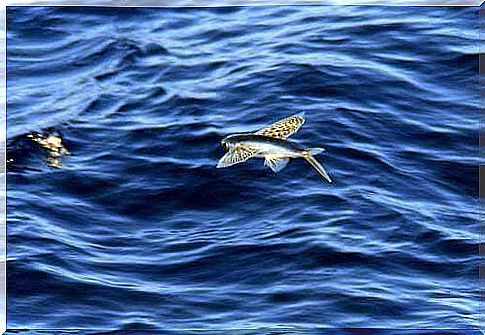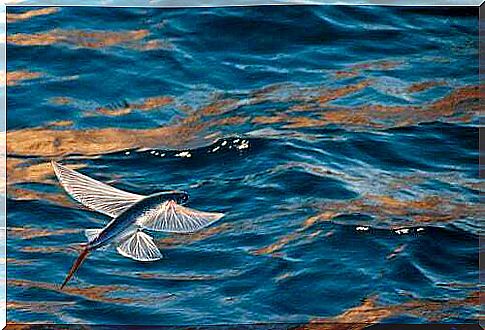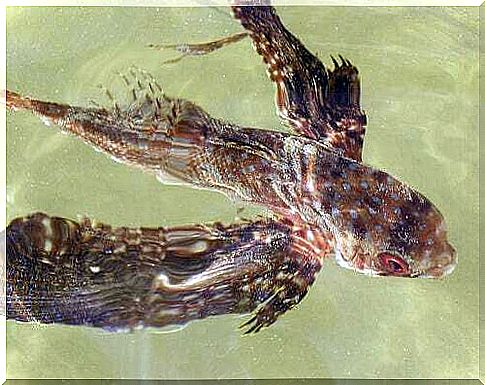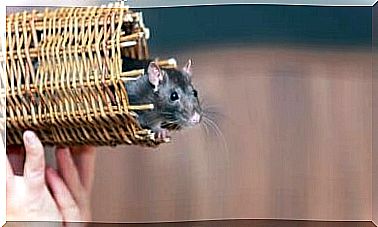Flying Fish: Curiosities And Characteristics

The Exocoetidae, known as flying fish or swallow fish, are a very curious species in the animal world, which has aroused the interest of researchers and navigators for many centuries. The feature that makes these fish unique is their ability to fly over the surface of the ocean for very long distances. In this article you will find curiosities and characteristics of flying fish.
There are more than 70 different types within the flying fish family or Exocoteidae . These 70 types are grouped into nine genres, although they all share similar characteristics.
The Exocoteidae have an aerodynamic constitution that allows them to reach high speeds. Their large pectoral fins help them glide over the water and redirect the wind.
The flight of flying fish generally hovers around 50 meters. However, flights of over 200 meters were recorded. Some species with dilated pelvic fins can move more than 400 meters above water.
None of the flying fish measure more than 30 centimeters. Despite this, it is necessary to clarify that the size will largely depend on the species of Exocoteidae.
Some of the largest finned species are those that inhabit tropical and subtropical waters on the west coast of the Atlantic Ocean. The fins of some species are almost as long as the animal’s body. Let’s discover together some curiosities and characteristics of flying fish.
Exocoteidae , an aerodynamic marvel
In general, researchers distinguish flying fish into two broad categories: two-winged fish and four-winged fish. Two-winged fish are those that have highly developed pectoral fins. On the other hand, fish with four wings have pectoral fins but also very developed pelvic fins, which allows them greater maneuverability.

It is worth clarifying that flying fish do not actually fly. The Exocoteidae not fly like a bird, they glide with the help of their large fins.
Some researchers have suggested that the morphology of flying fish evolved in this way to escape predators. In fact, if the fish comes out of the water, the hunt is over.
Some of the predators of the Exocoteidae are tuna and swordfish, although many other fish hunt them. In fact, when it leaves the water it becomes a prey for birds as well. This increases the risk of being eaten.
To “fly”, these fish must reach a very high speed in the water. Flying fish can swim at a maximum speed of 60 km / h. When they reach this speed, they head towards the surface at a not too steep angle.
Once they break the surface of the water, the flying fish spread their pectoral wings. At the same time, they keep flapping their tails to get more momentum.
After this first moment, a flying fish can reach a height of several meters and glide over the surface of the water. The Exocoteidae manage to stay out of the water for a long time thanks to the movement of the caudal fin. This fin is flapped 50 to 70 times per second to increase the flight of the fish.

Habitat, feeding and reproduction of flying fish
The Exocoteidae live in shallow waters off the coast. In general, they are found in warm, tropical and subtropical areas, although the morphology of the latter changes slightly.
They can be found in various seas and oceans of the world, but mainly in the warm waters of the Atlantic Ocean. The Mediterranean Sea is home to various types of Exocoetidae .
The flying fish diet consists mainly of plankton, a complex of very small living organisms that remain suspended in the water. Many other small fish feed on plankton for a living. In addition to plankton, Exocoetidae also feed on smaller fish.
The reproduction of these fish is oviparous. Females lay their eggs in algae or directly in the water. The eggs are held together by a kind of membrane of elastic threads. In the Asian market, Exocoetidae eggs are considered a delicacy and are very expensive.
There are currently many tourist tours to observe flying fish as they fly over the waters. In warm periods, many tourists go to areas with tropical waters to observe this phenomenon.
Unfortunately, the number of specimens is decreasing considerably due to indiscriminate hunting. In Asia, in particular, Exocoetidae are caught as food. Appropriate conservation measures need to be put into practice for this species, especially in the open sea.









